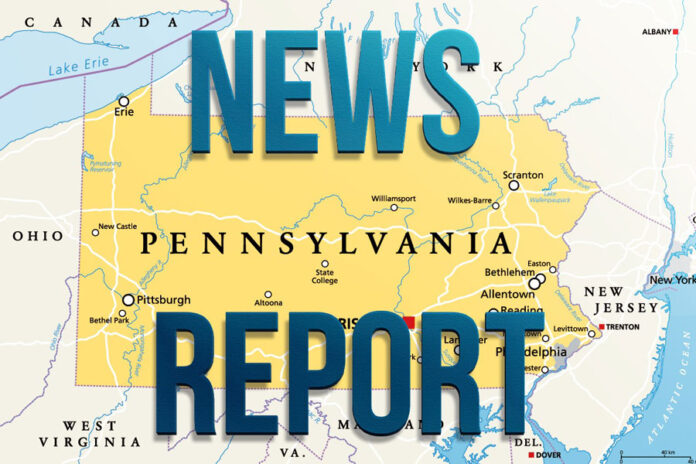PennLive. January 20, 2024
Editorial: Voters need to know where Pennsylvania’s Democratic candidates for Congress disagree
The Iowa Caucus has officially opened the 2024 presidential election season, but only 15 percent of the state’s registered Republican voters showed up. That’s a sad tally for a contest that received so much hype as the kickoff to an historic political season.
Let’s chalk it up the dismal voter turnout in Iowa to the brutally cold weather and not to a lack of enthusiasm for their candidates.
Here in Pennsylvania, the opposite seems to be true, at least among Democratic voters. It was a packed house at Widener University School of Law for the first meeting of Democratic contenders for Pennsylvania’s 10th Congressional district on Saturday, Jan. 13. The Dauphin County Democratic Party hosted all eight candidates trying to unseat U.S. Rep. Scott Perry. They are convinced Perry tried to overturn the 2020 elections that sent Joe Biden to the White House. And they see him as more vulnerable this year than ever before. They may be right.
Public Policy conducted a poll in October and found Perry has only a 34 percent approval rating in the 10th Congressional District. Add to that two facts: district voters soundly favored Gov. Josh Shapiro over far-right candidate Doug Mastriano in 2022; and political neophyte Justin Douglas turned the Dauphin County Board of Commissioners blue for first time in 100 years only months ago.
There’s good reason to think this is the year Democrats have a real chance to take Perry’s seat in the U.S. House of Representatives.
Democratic voters have until April 23 to decide which of the seven contenders has the best chance to win. All the candidates agree on most issues, from abortion rights, to preserving Obamacare to finally raising the minimum wage. What they don’t agree on is what voters need to know. They’ll have the next few months to try to figure that out.
The recent candidate’s forum revealed two major areas of contention: whether there should be a ceasefire between Israelis and Palestinians in Gaza, and whether a candidate should live in the district.
Janelle Stelson is the only candidate who doesn’t live in the 10th District, and, from her answer at the forum, she’s not sure if she ever will. She lives just outside its boundaries. “I look forward to what the future will hold,” she answered when directly asked if she planned to move into the district. Some people groaned at that answer, and rightfully so.
Candidate Mike O’Brien is also vulnerable on the residency point. He’s a veteran who maintained a home in Montgomery County, but at least he’s moved into the district. He plans to move his family there once their new home is built. That may get him off this hot seat.
The war in Gaza might be the biggest dividing line among the candidates. But the forum’s quick pace and short answers didn’t allow a deeper dive into their responses, some of which were far from direct on the question of support for a ceasefire.
John Broadhurst and Blake Lynch were unequivocal in calling for the war to stop. It’s not clear if any of the other candidates are demanding the same. And that’s a problem.
Voters deserve to know where the candidates stand on an important foreign policy issue that directly impacts our own national security. We urge all candidates to have the courage to make their positions crystal clear – whatever they are — and let the voters decide.
___
LancasterOnline/LNP. January 21, 2024
Editorial: It’s long past time for Pennsylvania to fund public schools fairly
When it comes to adequately funding school districts in Pennsylvania, we’ve developed a believe-it-when-we-see-it attitude.
We’re heartened by the Basic Education Funding Commission’s recommendation that the School District of Lancaster and other underfunded school districts get the resources they need to be part of the “thorough and efficient” public education system promised by the state constitution.
Just as we were heartened by the state Commonwealth Court ruling nearly a year ago that blasted the state for failing to adequately fund those school districts.
But will those underfunded school districts actually get the money they need?
We’ll believe it when we see it.
The minority report produced by the Republicans on the commission asserted that comprehensive “solutions, not funding alone, are required to ensure all school districts have the resources necessary to supply students with comprehensive learning opportunities that meet 21st century academic, civic, and social demands.”
Comprehensive solutions don’t just materialize out of the ether. They require financial investment.
As the AP/Report for America reported, state House Republican Leader Bryan Cutler of Drumore Township criticized the Democrats’ report as containing a “simply spend more money” solution to fix inadequacies in the commonwealth’s school funding system.
Nailed it in one, Rep. Cutler. That’s exactly what is needed: more money — to hire more experienced teachers in school districts with increasing numbers of English language learners and students with disabilities, so class sizes can be reduced; to bring buildings up to date, so districts can recruit teachers who will stay, and students can learn in environments that are conducive to their success; and to provide support services to students with diverse needs.
Republicans prefer funneling tax dollars to private-school tuition voucher programs. They don’t seem concerned about the inequitable distribution of school funding in Pennsylvania. And they’re asserting that hefty tax increases would be required to spend the billions more on schools that the Democrats recommended in the commission’s majority report.
But because the current school funding system is so heavily dependent on property tax revenues, local school districts have been raising school taxes for years. That’s part of the problem the funding commission sought to address.
All underfunded schools want is what the majority on the Basic Education Funding Commission has determined they need — the resource levels that the state’s successful school districts already enjoy.
Consider these pieces of testimony included in the commission’s majority report:
— Laura Boyce, executive director of Teach Plus Pennsylvania, a nonprofit aiming to empower teachers to lead on issues that advance equity, opportunity and student success, said that the lowest-wealth and most inadequately funded districts in Pennsylvania employ less-qualified teachers than adequately funded districts.
___
Pittsburgh Post-Gazette. January 23, 2024
Editorial: Washington’s Trail – 1753 deserves official historical recognition
In October 1753, 21-year-old George Washington set off from Williamsburg, Va., on a mission to deliver an ultimatum to French forces at Fort Le Boeuf in present-day Erie County, Pa. Washington’s route took him through Alexandria, Va., Cumberland, Md. and the Forks of the Ohio — pre-Fort Duquesne — a thousand-mile round trip.
This expedition was the first, but perhaps least famous, of Washington’s treks across the Alleghenies to what is now Pennsylvania. A consortium of Pennsylvania and West Virginia members of Congress, led by Rep. Mike Kelly, R-Butler, want to elevate this episode’s importance by designating Washington’s route as a National Historic Trail (NHT). There are currently 21 such trails, most of which commemorate western expansion, while others mark Revolutionary-era or earlier paths.
It’s a move that would make available federal resources to improve and market the route, and destinations along it, particularly in Pennsylvania where the trail is already signed and supported by a private organization. Congress should approve the bill directing the Department of the Interior to conduct a “feasibility study” on the route’s suitability as an NHT.
Pittsburgh-area drivers may recognize the round blue signs, featuring a white silhouette of the first president, labeled Washington’s Trail – 1753. The driving trail roughly follows Washington’s route along what became the National Road in Somerset and Fayette counties, north to Greensburg then west to the Point. From there, it goes up the Ohio River to the Native American settlement of Logstown, near Baden; north to Moraine State Park then along Route 8 to the Allegheny River at Franklin; then parallel to French Creek to Meadville and Waterford, where Fort Le Boeuf once stood.
The organization Washington’s Trail – 1753 was founded in 2000 to promote knowledge of this historic moment, and sites along the route. The group now partners with a dozen regional tourism agencies, and is said to be responsible for a modest boost in tourism spending in Butler County.
A National Historic Trails designation would supercharge that impact, which currently measures in the tens of thousands, possibly to the millions.
Nearly a decade ago, Mr. Kelly requested a “reconnaissance survey” from the National Park Service, the purpose of which is to preliminarily determine how a proposed trail would perform in a full “feasibility study.” (Everything in government is more complicated than you’d expect.) The tedious 73-page survey report determined that Washington’s Trail – 1753 would only fulfill one of three mandated criteria for an NHT. The criteria, however, are vague, and the report’s arguments unconvincing. As with so many bureaucratic determinations, it easily could have gone the other way, and Congress should not be discouraged.
If, however, the federal recognition route fails, we hope state lawmakers will take up the cause. The commonwealth’s portion of Washington’s Trail – 1753 could, and should, be considered for inclusion as a Pennsylvania Trail of History.
No matter how it happens, the route of Washington’s trek to Fort Le Boeuf deserves official recognition to boost knowledge of this fascinating historical episode — and tourism in Western Pennsylvania.
___
Scranton Times-Tribune. January 20, 2024
Editorial: Senate GOP should allow debate on a statewide assault-weapons ban
Since George Banks began his 13-victim killing spree on Schoolhouse Lane in Wilkes-Barre in 1982, through the antisemitic shooting that left 11 worshippers dead in a synagogue in the Squirrel Hill section of Pittsburgh in 2018, to last summer’s shooting spree in Philadelphia that took five lives, at least 59 Pennsylvanians have died in mass shootings involving semi-automatic weapons. Yet in all that time, the General Assembly has done little to restrict the sale of those firearms or the high-capacity magazines that help make them so deadly.
Last week, Democrats on the House Judiciary Committee, in a party-line vote, advanced a bill that would have the commonwealth join 10 other states in banning the sale of semi-automatic weapons. A vote on the House floor probably won’t occur until after a February special election that will break a 101-101 tie between Democrats and Republicans in the chamber. But even if the bill were to pass the House, history suggests it is unlikely to get a hearing in the Republican-controlled Senate. A gun-safety package passed in the House last year was never called up in committee in the upper chamber. That’s a pity, because the citizens of Pennsylvania deserve an open debate on the ready availability of weapons capable of inflicting such unimaginable carnage in the blink of an eye.
Arguments that an assault-weapons ban would make the Second Amendment a “second-class amendment” ring hollow when one considers there are numerous laws regulating the sale and possession of firearms and a whole host of certain weapons cannot legally be sold to the general public. Americans already own an estimated 20 million assault-style rifles and it is difficult to imagine who would benefit from adding to the total, save gun manufacturers.
The United States banned the sale of such weapons from 1994 to 2004 with no harm to the republic, but Congress regrettably allowed the ban to lapse. Since then, a number of studies have reached conflicting findings on the effectiveness of such bans. In an independent review of studies of statewide bans last year, the Rand Corp. noted there was some evidence they reduced mass shootings, but found it inconclusive. There was stronger evidence, however, that bans on high-capacity magazines did reduce mass shootings.
That very uncertainty should motivate the General Assembly to further probe the question rather than allow the House bill to wither through the type of legislative gamesmanship that too often gridlocks our politics in Harrisburg and Washington.
Polling shows Pennsylvanians broadly support stricter gun laws when it comes to red flag laws, expanded background checks and safe storage. Their views on an assault-weapons ban are less clear. That’s why it is incumbent on the state Senate to allow a full examination and debate on the bill pending in the House.
___
Uniontown Herald-Standard. January 20, 2024
Editorial: Summer food program an important way to keep children fed
Given temperatures in recent days that have been more akin to what you would experience in Fairbanks, Alaska, or the outback of Finland, it can seem like summer is a long, long way away.
But it will be here before you know it. Memorial Day is just four months away. The first Pirates game is just two months away. By then, the sweaters we are wrapping ourselves in now will again be stashed in the deeper recesses of our closets.
And although most of us relish the idea of summer in the dead of winter, those warm-weather months can be a trying time for families that rely on free or reduced-price lunches during the school year. After all, the need for three nutritious meals a day doesn’t go away once the windows open and air conditioners are fired up.
A new federal program seeks to fill this gap by giving eligible families $120 per child in June, July and August that would allow them to purchase food at grocery stores and other approved outlets. The federal government covers all of the costs and half the administrative costs, leaving the other half to participating states. Making sure that all children have access to food outside the school year is not only compassionate, but a wise investment in our future – children who grow up in food-insecure households are more likely to have behavioral problems, developmental delays, and chronic illnesses, which costs all of us in the long run.
All told, an estimated 17 million households are classified as food insecure, a number that has gone up since pandemic aid ended. This makes a summer food program all the more important.
Pennsylvania is, thankfully, among the states participating. The administration of Gov. Josh Shapiro is linking it to its efforts to provide universal free breakfast for school children. Khalid Mumin, the commonwealth’s education secretary, said, “Children cannot learn on empty stomachs, and the need for healthy and nutritious meals does not end with school.”
That seems obvious, but unfortunately 15 states opted not to participate in the program by the time the Jan. 1 deadline rolled around. All are led by Republicans. Some said they didn’t have the administrative apparatus in place to deal with the program, but left the door open to participate in the future. However, some states are declining to take the federal funds, it seems, on purely ideological grounds.
Nebraska Gov. Jim Pillen, for example, said his state was not going to participate because, in his words, “I don’t believe in welfare.” And Iowa Gov. Kim Reynolds said the program “does nothing to promote nutrition at a time when childhood obesity has become an epidemic.”
So we fight childhood obesity by…denying food to children?
If we truly care about our children, making sure they have enough to eat in every month of the year should be among our top priorities.
























